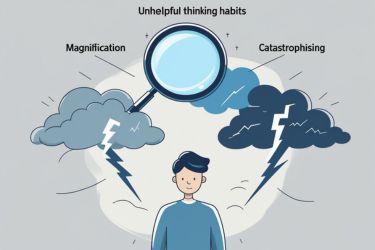Disqualifying the positive is a common thinking error that can silently undermine our happiness and mental health. This cognitive distortion leads us to disregard or minimise positive experiences, making it difficult to appreciate the good in our lives. Many of us might not even recognise that we are doing this, which can create a cycle of negativity that affects our mood and self-esteem.

When we focus solely on the negatives, we miss out on the joy that can come from acknowledging our achievements and positive experiences. This skewed thinking not only impacts our perceptions but also shapes our behaviours and interactions with others. By understanding this habit, we can begin to shift our thought patterns and open the door to a more balanced perspective.
Learning to counteract disqualifying the positive is crucial for improving our overall well-being. By integrating healthier thinking styles and recognising the value of our experiences, we can foster a more positive mindset.
Key Takeaways
- Disqualifying the positive can harm our mental health by drowning out positivity.
- Recognising this cognitive distortion helps shift our thought patterns.
- Integrating healthier thinking styles can improve our overall well-being.
Understanding Disqualifying the Positive

Disqualifying the positive is a specific type of negative thinking that can distort our view of reality. This section explores its definition, roots in cognitive distortions, and how it appears in our daily lives.
Definition and Key Characteristics
Disqualifying the positive refers to the tendency to dismiss or downgrade positive experiences or achievements. We might achieve something worthwhile but still focus on the negatives instead of recognising our success.
Key characteristics include:
- Mental Filtering: We concentrate on negative details while overlooking the positive aspects.
- Distorted Thoughts: This thought pattern can lead to a drastically imbalanced view of ourselves and our circumstances.
- Negative Self-Perception: We may think we don't deserve good outcomes, reinforcing a negative mindset.
Recognising these traits can help us identify when we are disqualifying the positive.
Origins Within Cognitive Distortions
Disqualifying the positive is a part of cognitive distortions, which are flawed ways of thinking that can affect our emotions and behaviours. These distortions often arise from negative experiences, upbringing, or societal pressures.
Within the cognitive model, we learn to build patterns of thinking that reinforce our beliefs. Over time, we may develop a habit of viewing situations through a negative lens. This can create a cycle that affects our mental health, contributing to anxiety and depression.
Understanding these origins is essential in learning to challenge and change our thought patterns.
How Disqualifying the Positive Manifests
We can see disqualifying the positive in various situations. For instance, after receiving praise for a job well done, we might think, "They were just being nice," instead of accepting the compliment.
Other examples include not celebrating small wins or feeling guilty about achievements. We might convince ourselves that success is due to luck, not skill or effort.
This pattern can lead to a lack of motivation, as we may feel our efforts will never truly matter. Recognising these moments is a crucial step towards fostering a more balanced and positive outlook in our lives.
The Impact of Disqualifying the Positive on Mental Health

Disqualifying the positive affects our mental well-being in various significant ways. It can contribute to anxiety and depression, lower our self-esteem, and lead to negative thinking patterns. We need to recognise these impacts to address and manage them effectively.
Effects on Anxiety and Depression
Disqualifying the positive often heightens feelings of anxiety and depression. When we focus only on negative experiences and dismiss our successes, we create a cycle of self-doubt. This can lead to persistent worry and sadness.
In our daily lives, this might look like receiving praise for a job well done yet only fixating on mistakes. Such patterns can worsen our mental state, leading to overwhelming feelings of inadequacy. Our mind may convince us that we are not good enough, amplifying the symptoms of anxiety and depression.
Influence on Self-Esteem and Negative Emotions
Low self-esteem is closely linked to disqualifying the positive. When we ignore our accomplishments, we undermine our self-worth. This behaviour can leave us with negative emotions like frustration and hopelessness.
We may find ourselves doubting our abilities in various aspects of life. This could affect our relationships, work performance, and general happiness. The more we engage in this habit, the less we appreciate our strengths, further damaging our self-esteem.
Connections to Mental Illness and Negative Thinking
Disqualifying the positive can contribute to the development of mental illness. It reinforces negative thinking patterns that can escalate into more severe issues, such as chronic depression or anxiety disorders.
We might start to see the world through a negative lens, impacting how we perceive ourselves and our surroundings. This pattern is unhealthy and can create a barrier to seeking help. Recognising and addressing disqualifying the positive is essential for maintaining our mental health.
Related Cognitive Distortions and Unhelpful Thinking Styles

Unhelpful thinking styles often overlap, presenting us with distorted perceptions of reality. By recognising related cognitive distortions, we can better understand how our thoughts may mislead us. Here are some key unhelpful thinking styles associated with disqualifying the positive.
Filtering and Magnification
Filtering involves focusing solely on the negative aspects of a situation while ignoring the positives. For example, we might receive praise for our work but only remember the few critical comments. This mental filtering leads to a skewed perception of reality.
Magnification is similar but involves blowing negative experiences out of proportion. When we magnify our mistakes, we may feel worthless for small errors. This can lead us to believe that one setback defines our entire worth, affecting our self-esteem and decision-making.
Overgeneralisation and All-or-Nothing Thinking
Overgeneralisation occurs when we apply one negative experience to all future situations. If we fail at one task, we might tell ourselves we will always fail. This thinking style limits our potential and growth, as we believe we cannot succeed.
All-or-nothing thinking, known as polarized thinking, pushes us to see things in extremes. We may consider ourselves a total failure if we do not achieve perfection. This way of thinking leads to frustration and discouragement, making it hard to appreciate our efforts or progress.
Catastrophising, Emotional Reasoning, and Personalisation
Catastrophising is when we imagine the worst possible outcome in a situation. This can cause us to panic unnecessarily, leading to avoidance behaviours. For example, we might worry that a minor mistake will result in losing our job.
Emotional reasoning relies on feelings to judge reality. If we feel anxious, we might think something terrible is about to happen, even if there’s no evidence. This can trap us in a cycle of worry, as our emotions skew our understanding.
Personalisation involves taking responsibility for events outside our control. We may feel responsible for someone else's bad mood or situation, leading to unnecessary guilt. Recognising these patterns can help us challenge our thinking and develop healthier perspectives.
How Disqualifying the Positive Shapes Thought Patterns

Disqualifying the positive greatly impacts how we think and view ourselves. Negative thoughts often take precedence, shaping our self-talk and influencing our behaviours. This can lead to unhealthy habits that reinforce negative views.
Automatic Thoughts and Negative Self-Talk
Automatic thoughts are quick, often unconscious responses we have to situations. For example, when we achieve something, we might brush it off with “It’s not a big deal.” This habit of disqualifying our achievements leads to negative self-talk.
Negative automatic thoughts can affect our self-esteem and confidence. When we constantly tell ourselves we aren’t good enough, we begin to believe it. This harmful cycle keeps us trapped in a negative mindset, making it hard to recognise our strengths or accomplishments.
Self-Fulfilling Prophecies and Learned Helplessness
A self-fulfilling prophecy occurs when our beliefs about ourselves lead to outcomes that confirm those beliefs. If we think we will fail, we may not try hard enough, leading to failure. This reinforces the negative thought that we are not capable.
Learned helplessness further compounds this issue. It happens when we experience repeated failures, leading us to feel powerless to change our situation. This feeling can cause us to stop trying altogether, which continues the cycle of defeat. We find ourselves unable to see positive possibilities.
Developing Distorted Thinking Habits
Distorted thinking habits form when we consistently engage in negative thought patterns. These may include black-and-white thinking, catastrophising, or discounting the positive. For instance, if we receive positive feedback but focus only on criticism, we reinforce our negative self-view.
As these habits take root, they become automatic. Our brains become wired to focus on the negative, overshadowing any positive experiences. This constant reflection on the negative creates a barrier to personal growth and happiness, making it difficult to break free from these thought traps.
To combat this, it’s crucial to consciously challenge and reframe our thoughts, recognising our achievements and worth. Developing healthier thinking patterns takes effort but can lead to significant changes in our mindset.
Therapeutic Approaches to Overcome Disqualifying the Positive
To combat the tendency of disqualifying the positive, we can use various therapeutic approaches. These methods, including cognitive restructuring and insights from psychotherapy, are designed to help us recognise unhelpful thinking patterns and replace them with more balanced thoughts.
Cognitive Restructuring and CBT Techniques
Cognitive restructuring is a key component of cognitive behavioural therapy (CBT). It helps us identify and change negative thought patterns. In this process, we first notice when we disqualify positive experiences.
Next, we challenge these negative beliefs. For example, if we think, “I only did well because my team helped,” we can reframe it to, “I contributed effectively to our success.” By focusing on our specific actions and achievements, we can train our minds to appreciate our efforts.
CBT offers practical strategies, such as thought records, where we write down our negative thoughts and the evidence for and against them. This technique encourages us to see the bigger picture and recognise positives in our experiences.
Role of Cognitive Therapy and Psychotherapy
Cognitive therapy plays a significant role in addressing disqualifying the positive. Through guided sessions, therapists help us explore the origins of our negative thinking. They provide a safe space for us to share our thoughts and feelings, allowing for deeper understanding.
In psychotherapy, we learn to recognise patterns in our thinking and behaviour. By discussing our experiences, we uncover how past events influence our current thought processes. This awareness helps us break the cycle of self-doubt and enables us to embrace positive aspects of our lives.
Therapists may also use techniques such as mindfulness to help us stay present. Being aware of our thoughts without judgment allows us to appreciate positive moments as they happen.
Practical Steps to Encourage Balanced Thinking
We can take several practical steps to foster balanced thinking. One effective method is to create a gratitude journal. Each day, we can write down three positive things that happened, no matter how small. This simple practice helps shift our focus to what is good in our lives.
Another strategy is to practise self-compassion. When negative thoughts arise, we can respond gently to ourselves, asking, “What would I say to a friend in this situation?” This promotes a kinder, more understanding inner voice.
Lastly, engaging in positive affirmations can reinforce our self-worth. By repeating statements like, “I am capable and deserving of success,” we challenge negative beliefs and build a more balanced self-image. Through these practical methods, we can significantly reduce the habit of disqualifying the positive.
Integrating Healthier Thinking Styles
We can shift our thinking patterns to promote better mental well-being. By integrating healthier thoughts, we can combat negative thinking habits, such as disqualifying the positive. Let’s explore some practical strategies.
Replacing Unhelpful Patterns with Positive Self-Talk
One effective way to combat negative thinking is by replacing unhelpful thoughts with positive self-talk. We often fall into the trap of “should” statements, leading to feelings of failure. Instead, we can rephrase these thoughts. For example, instead of saying "I should succeed," we can tell ourselves, "I can try my best."
We should also challenge labelling and mislabelling. Instead of calling ourselves "failures," we can acknowledge mistakes as opportunities for growth. This shift allows us to see our experiences more clearly, without the weight of harsh labels.
Additionally, employing affirmations can help reinforce positive thoughts. Regularly reminding ourselves of our strengths can improve our self-image and counteract negativity.
Building Intuition and Balanced Judgement
Strengthening our intuition allows us to assess situations more accurately. Instead of mindreading and assuming what others think, we can focus on our own feelings and perceptions.
To foster balanced judgement, we should practice evaluating evidence. When we feel negative, we can ask ourselves, "What evidence do I have for this thought?" This method helps us distinguish between reality and unfounded fears.
By taking a step back and examining our thoughts, we can minimise negative patterns. This rational approach encourages us to view situations more objectively, reducing undue stress.
Long-Term Maintenance of Change
Sustaining healthier thinking styles requires ongoing effort. We should actively monitor our thoughts, addressing negative patterns as they arise. Keeping a thought journal can serve this purpose. We can note down unhelpful thoughts and challenge them daily.
Building a support system is equally vital. Engaging with others who also aim to improve their thinking can provide the encouragement we need. Sharing our experiences can help us stay accountable.
Lastly, practising mindfulness can enhance our awareness of thoughts. Through mindfulness exercises, we learn to recognise our thoughts without judgement, creating space for healthier perspectives. This proactive approach is key to maintaining positive change over time.
Frequently Asked Questions
In this section, we will address some common questions regarding disqualifying the positive. We will look at examples, ways to challenge this habit, and exercises to help improve our thought patterns.
What are common examples of disqualifying the positive in thought patterns?
Disqualifying the positive often shows up in various ways. For instance, we might receive praise after a presentation but think, “They were just being nice.”
Another example is when we achieve a goal but focus only on what we did wrong. These thoughts prevent us from fully appreciating our successes.
How can one effectively challenge and alter the tendency to discount positive experiences?
To challenge this tendency, we can start by identifying our negative thoughts. We can ask ourselves if these thoughts are realistic or justified.
We should try replacing negative thoughts with balanced ones. For example, if we think, “I never do anything right,” we can reframe it to, “I can improve, but I have had successes too.”
What exercises can help in overcoming the habit of dismissing the positive?
Keeping a gratitude journal can be a helpful exercise. Each day, we can write down three positive things that happened, no matter how small.
We can also practice mindfulness. This helps us become more aware of our thoughts, allowing us to recognise when we are dismissing the positive.
Could you describe the distinction between 'mental filtering' and 'disqualifying the positive' in cognitive behaviour?
Mental filtering involves focusing solely on the negative aspects of a situation while ignoring the positives.
In contrast, disqualifying the positive is about recognising positive experiences but downplaying or dismissing them. Both are harmful, but they manifest in different ways.
In what ways can disqualifying the positive impact one's overall mental health?
This habit can lead to feelings of low self-worth and increased anxiety.
When we fail to acknowledge our positives, we can become stuck in a cycle of negativity. This can ultimately affect our relationships and daily motivation.
Are there specific strategies to recognise and correct all-or-nothing thinking?
To recognise all-or-nothing thinking, we can monitor our language. Words like “always” or “never” can signal this mindset.
We can correct it by looking for the grey areas in situations. We should ask ourselves if there are other possibilities or outcomes besides the extremes we initially see.




















